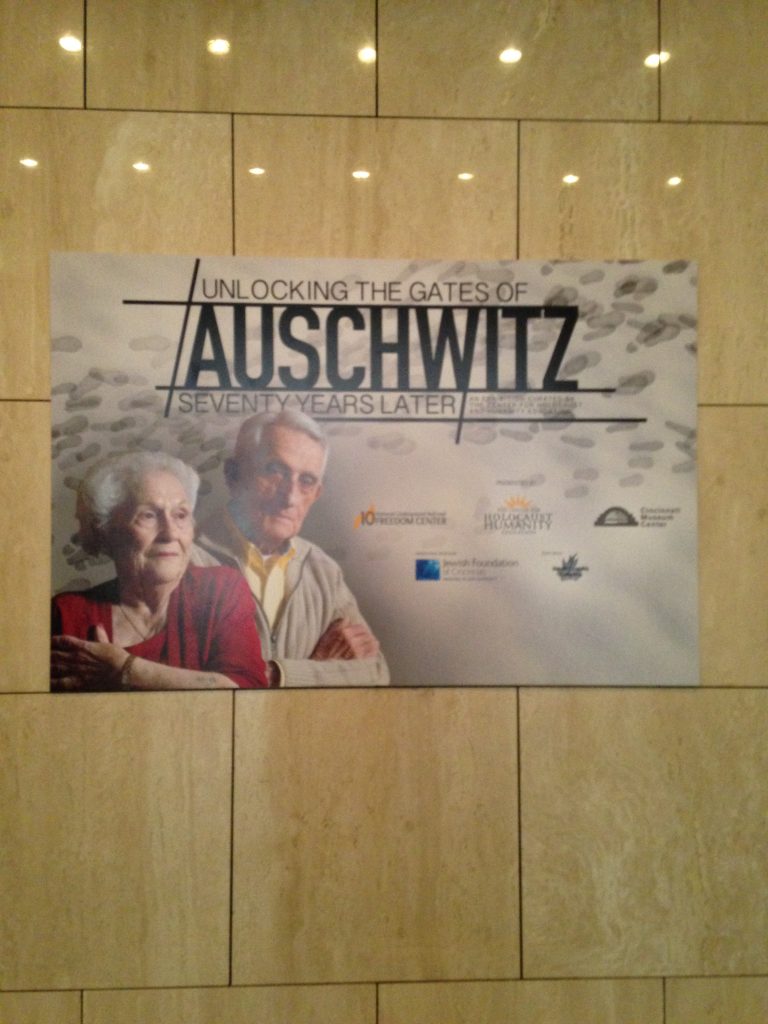
In 2015, I decided to visit the National Underground Railroad Freedom Center when I learned that they were hosting the exhibit, Unlocking the Gates of Auschwitz, Seventy Years Later. While it was a small showcase of over 100 artifacts and memorabilia, what interested me most were the testimonies of two amazing Holocaust survivors who later immigrated to Cincinnati.
In 1943, Werner Coppel and Bella Ouziel were deported to Auschwitz-Birkenau. Coppel escaped during a death march and hid in the woods for a week until the camp was liberated by the Soviet Army in 1945. Bella Ouziel of Greece survived a death march to Bergen-Belsen, set free by the British in August of 1945.
The purpose of the exhibit was to “give a voice to the survivors and eyewitnesses of Auschwitz and invite us today to stand up against injustice around the world.” Many of the items on display for the first time come from private collections, archives and libraries. Curated by the Center for Holocaust and Humanity Education, the Cincinnati Museum Center and the National Underground Railroad Freedom Center collaborated to make this exhibit available.
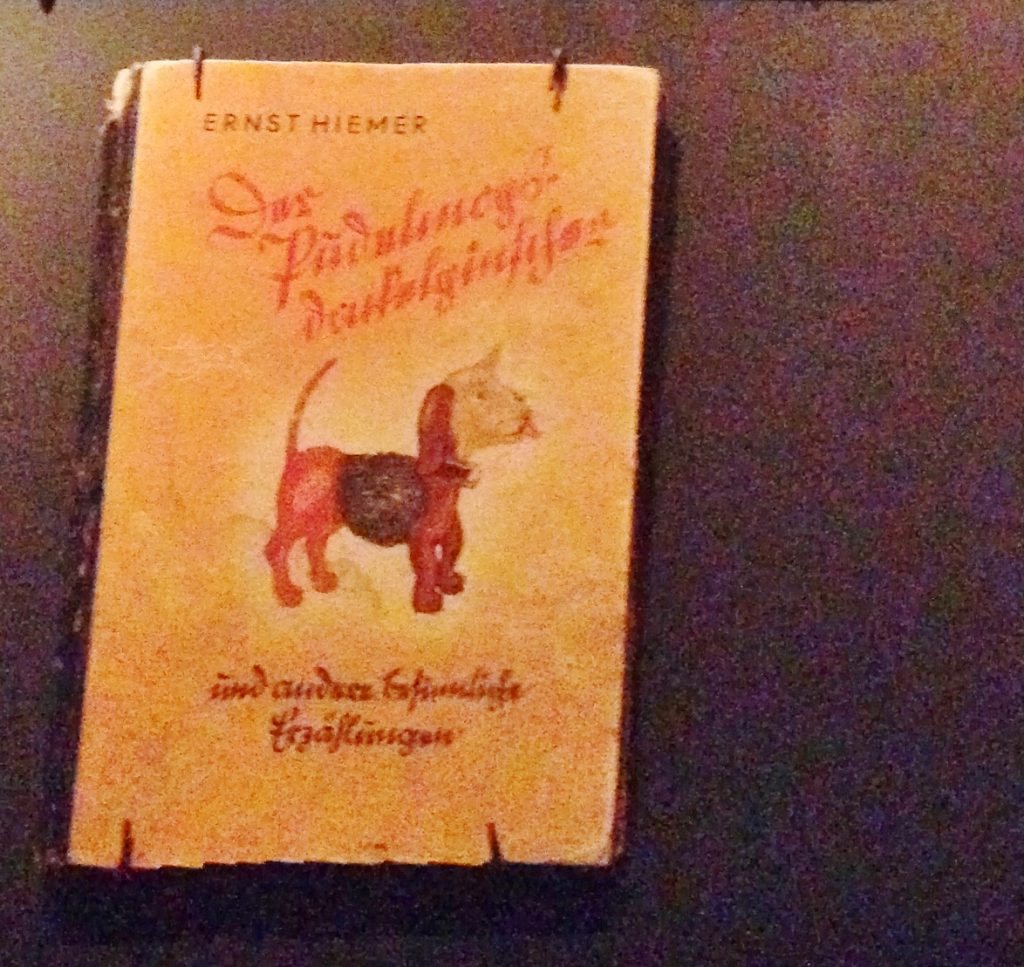
Long before concentration and death camps were planned by the Germans, Adolf Hitler was developing the Nazi ideology with this political manifesto and attempt to overthrow the Weimer government. By the mid-1930s, when Hitler came into power, propaganda against the Jews targeted impressionable children and anti-Semitic pamphlets were distributed throughout the country. Defining Jews as a “race”, the Nazis were able to brainwash the Germans into thinking that they were a genetically pure race compared to the Jews who were considered “subhuman.”
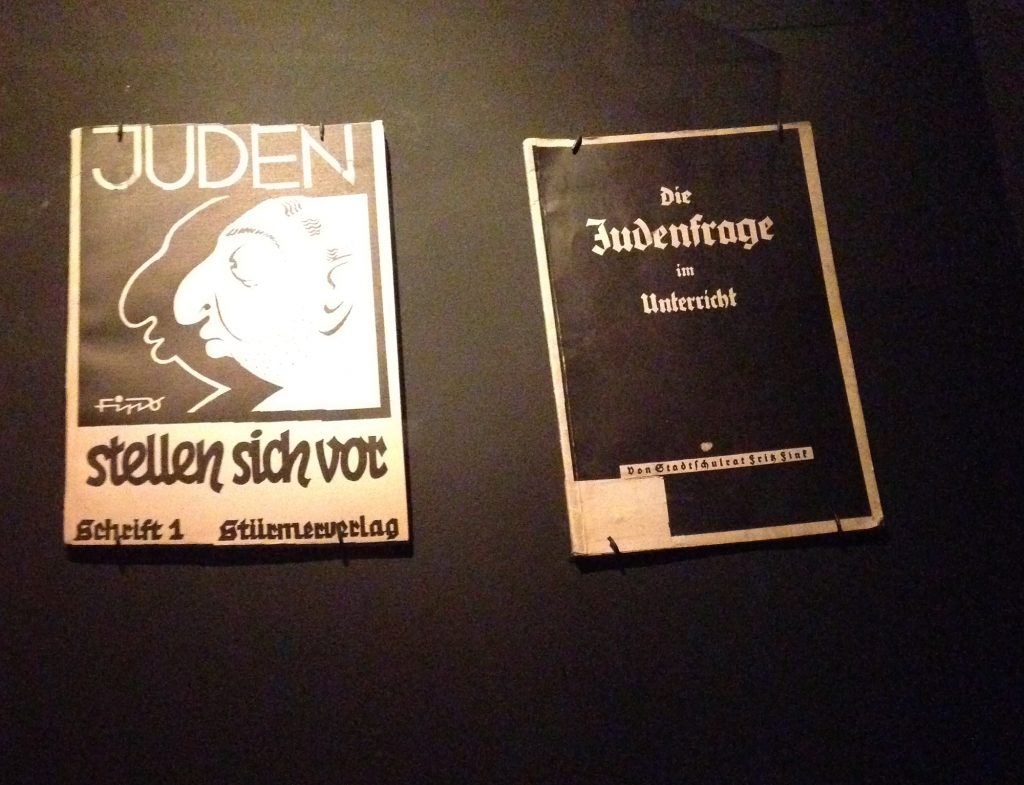
In addition, publications were developed to paint a negative view of anyone who disagreed with Hitler’s dogma and were considered enemies of the “Aryan” race. Manuals were provided to school teachers, training them in a destructive way of thinking towards Jews, gypsies, Poles, homosexuals, Afro-Germans and people with disabilities.
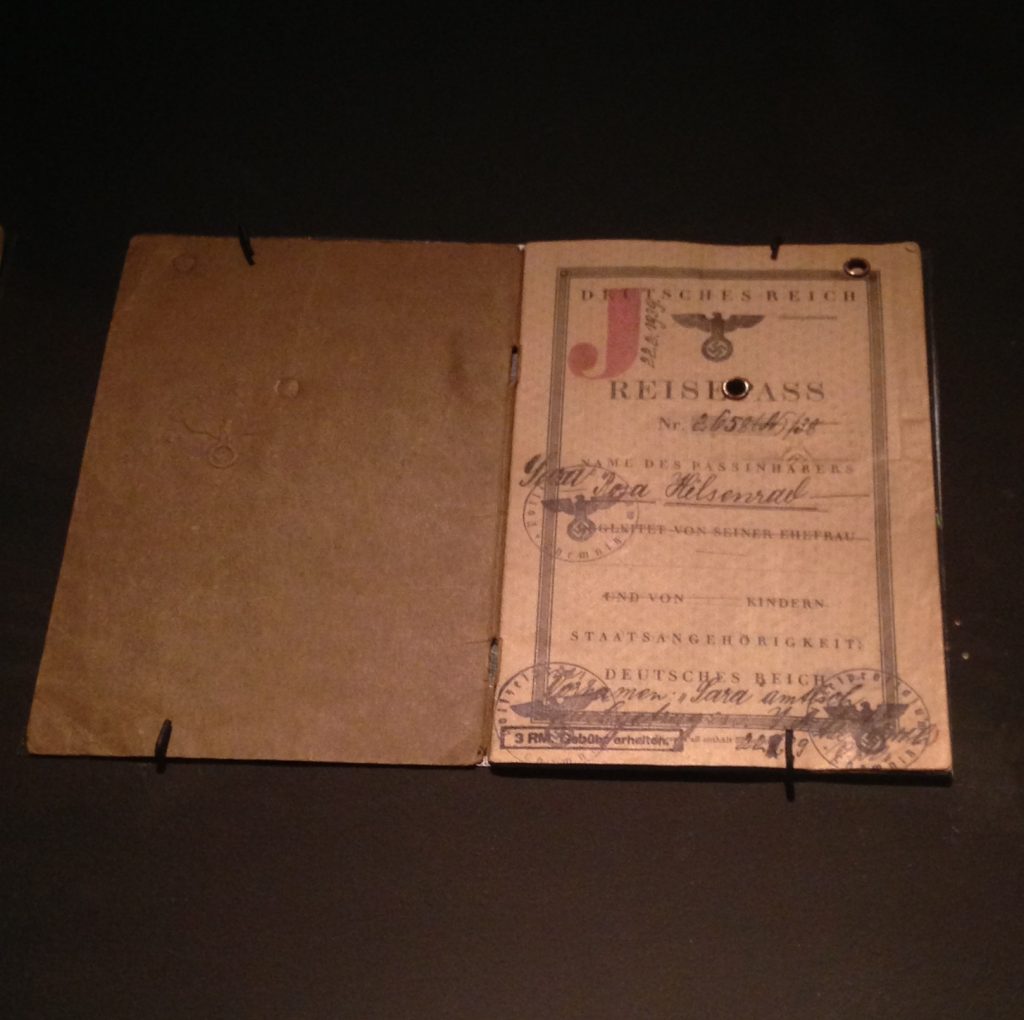
By 1938, passports held by Jews were identified with a red “J”.
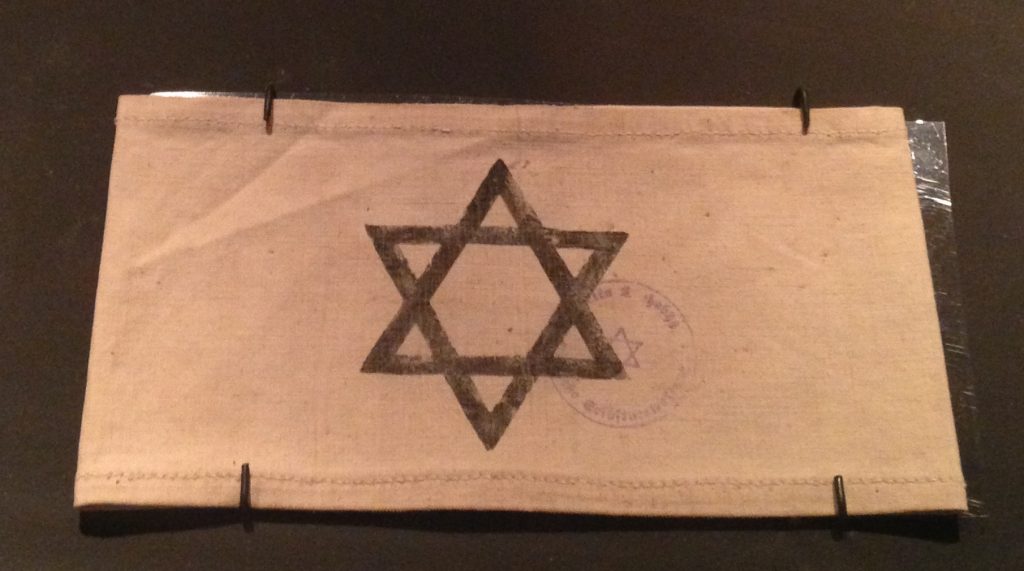
By 1940, Jews were segregated into areas identified as ghettos and were required to wear the Jewish Star of David which would later identify Jews during the German deportation of Jews throughout German-occupied European countries.
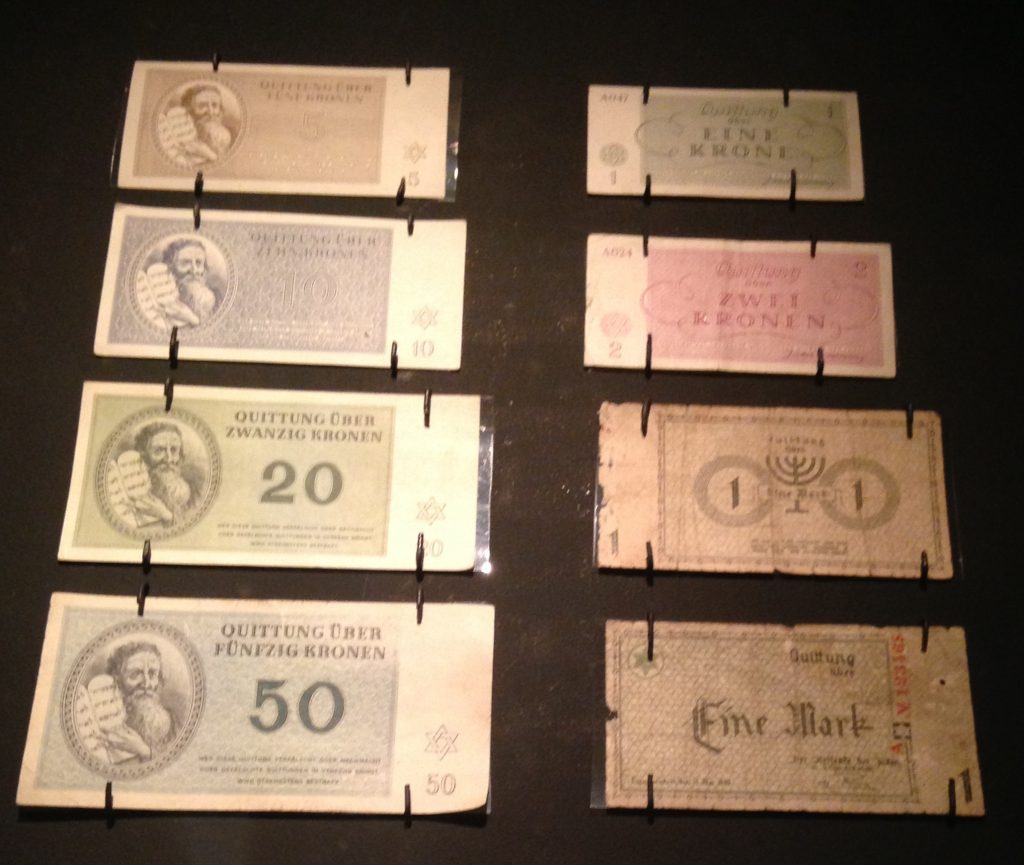
The ghettos were the initial location where Jews were required to “carry out forced labor for the German Reich.” The Germans collected the currency owned by the Jews and exchanged the money for “Quittung”, which were receipts which could be traded for services or merchandise.
While these Jewish neighborhoods were meant as a short term solution for Jewish segregated housing, many died from disease, shootings and starvation. If they survived the ghetto, they were deported to one of several concentration or death camps throughout German-occupied countries.
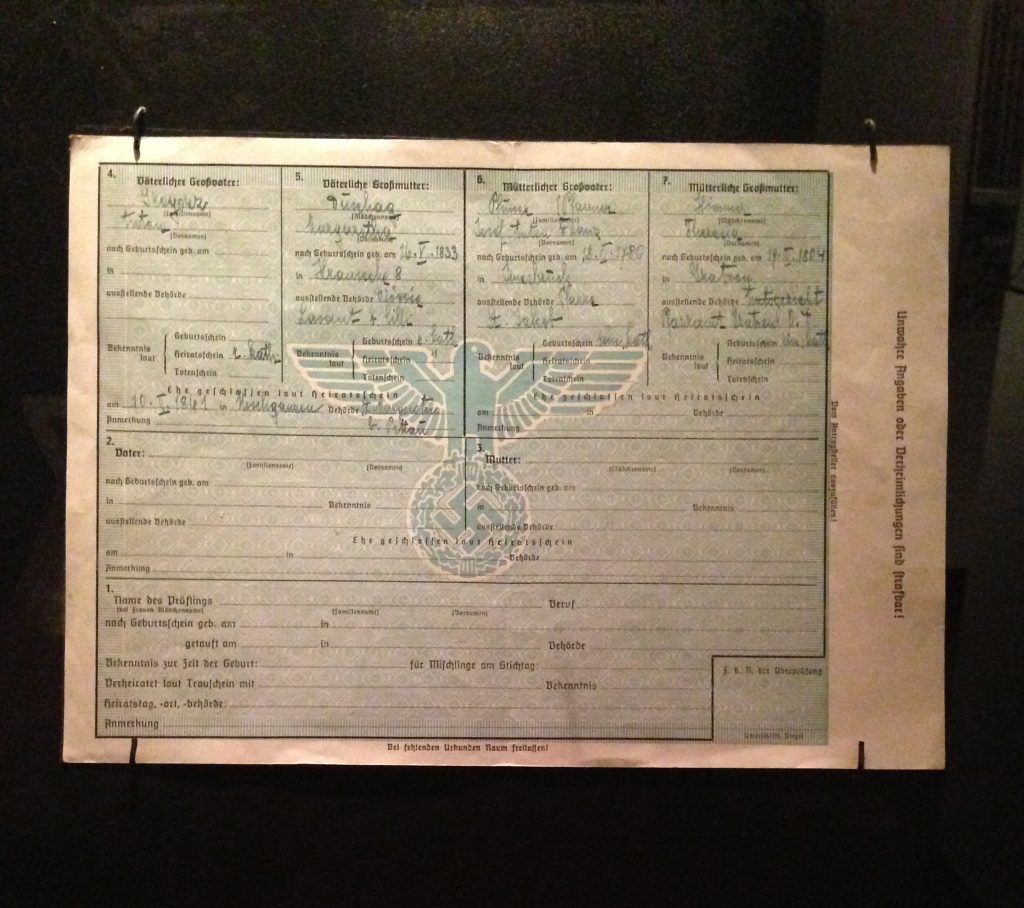
Adolf Hitler idolized Charles Darwin and believed in the “the survival of the fittest.” He intended to create the “perfect race” to include the traits that affected appearance, body type, intelligence, and military skill. Having created his list of ideal characteristics, he began to determine one’s “racial purity” researching documentation of family histories and birth certificates.
“Transport trains began to deliver Jews in early 1942 as part of the Nazi extermination plan. Cramped rail cars without adequate food, shelter or facilities. Upon arrival, they went through a selection process where they were either deemed fit for work and admitted into the camp or were deemed unfit for work and sent immediately to one of four gas chambers where they were killed using Zyklon B, a pesticide. Those selected for extermination were primarily children, women with small children, sick or elderly. Their bodies were removed from the gas chambers by the sonderkommando, groups of Jews forced to dispose of the corpses on threat of their own deaths.” Auschwitz Exhibit
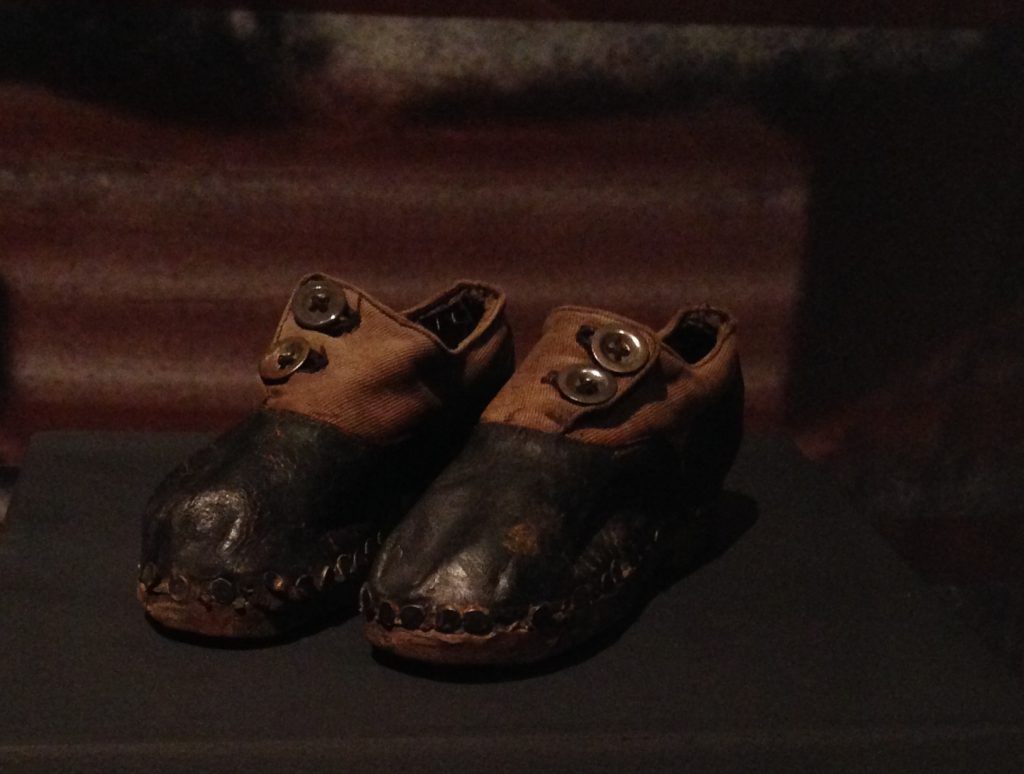
When children arrived to Auschwitz, they were, more often than not, immediately sent to the gas chambers. Children aged 12 and over were forced to work in the camps and were subject to medical experimentation. While thousands of children survived (because they were hidden), it was estimated that over 1.5 children were killed during the Holocaust.
With such disdain for children, it seems ironic that the prison camps were making children’s shoes at work camps such as Buchenwald as well as Auschwitz. Bella Ouziel, a Holocaust survivor discusses how she was required to sort shoes at Auschwitz.
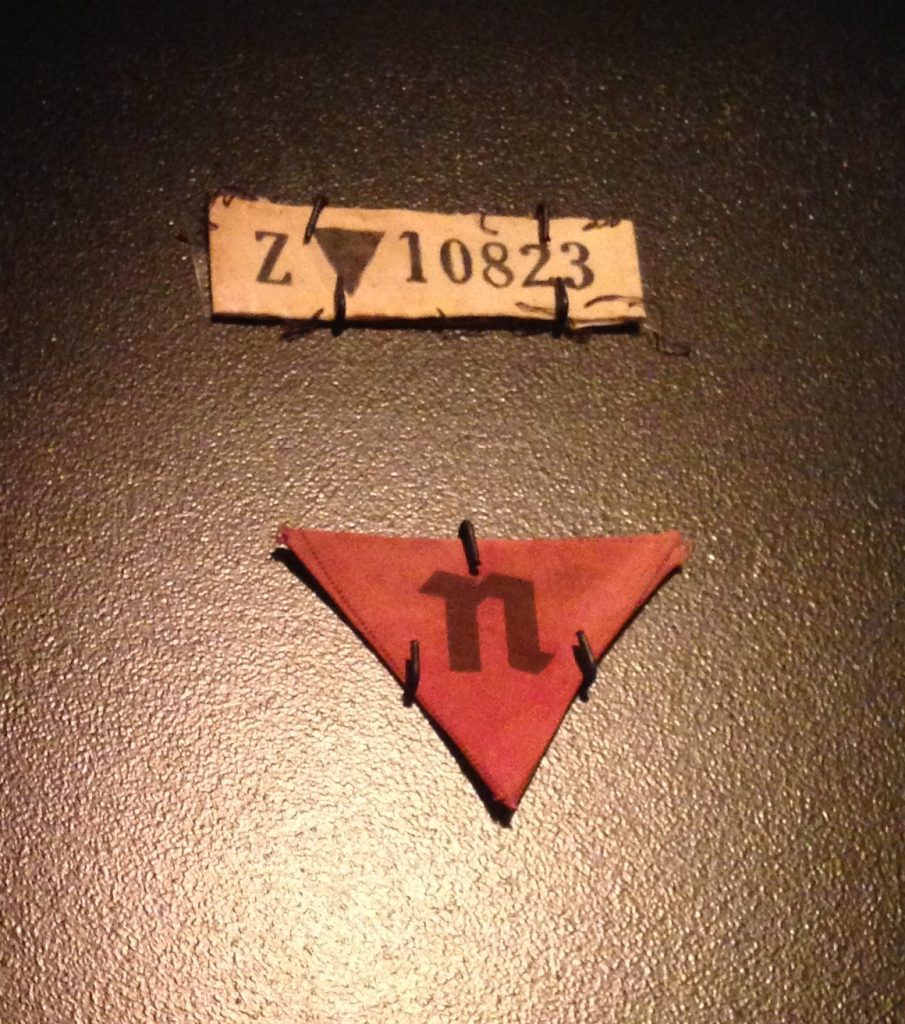
Non-Jewish groups were also transported to the concentration and death camps during the Holocaust to include the Gypsies. They were identified by brown triangle patches with an assigned number. The Romas, or Sintis, were considered undesirable and were murdered in the tens of thousands, dying in gas vans poisoned with carbon monoxide.
“Bella Ouziel remembers the transport of Roma where were sent to the family camp. She remembers that the next day, they had all been sent to the crematorium ca, 1943” – The Auschwitz Exhibit
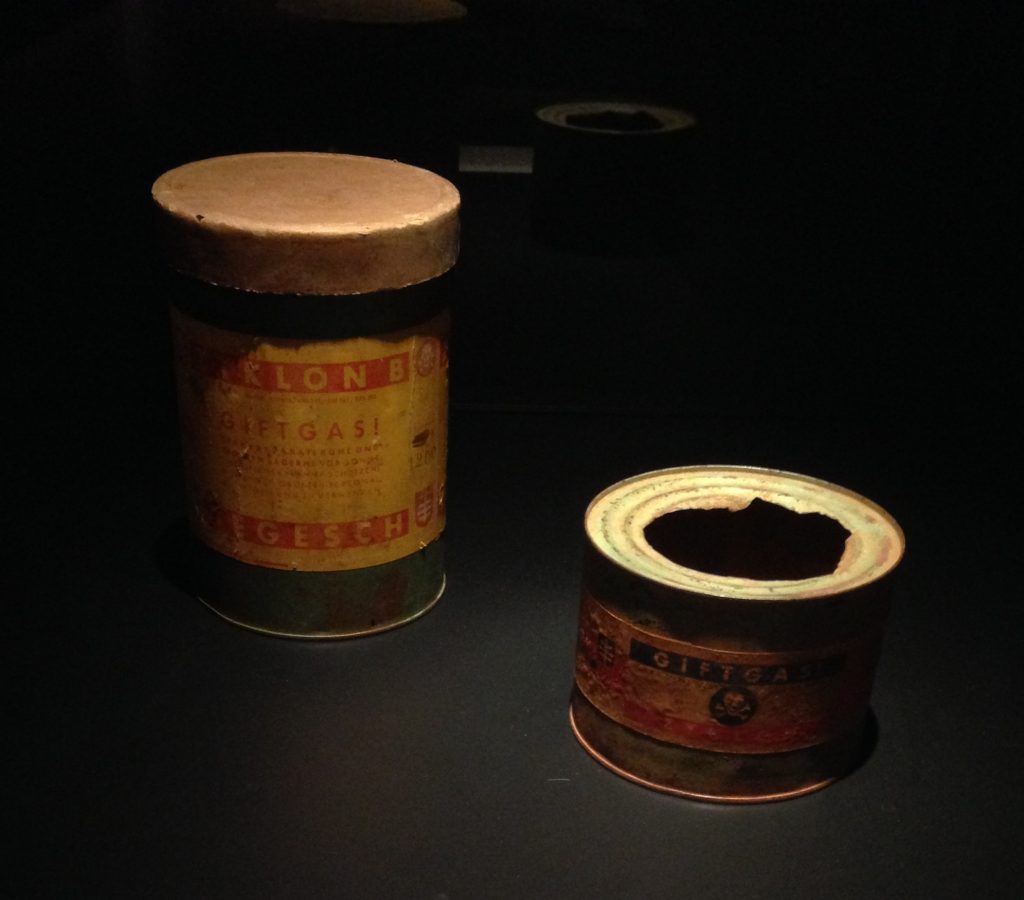
Within the extermination camps, the Nazi’s began to use canisters containing Zyklon B pellets to carry out their “Final Solution”. Commonly used as a pesticide, Zyklon B was used in Auschwitz to murder Soviet POWs and it was later used at the other camps.
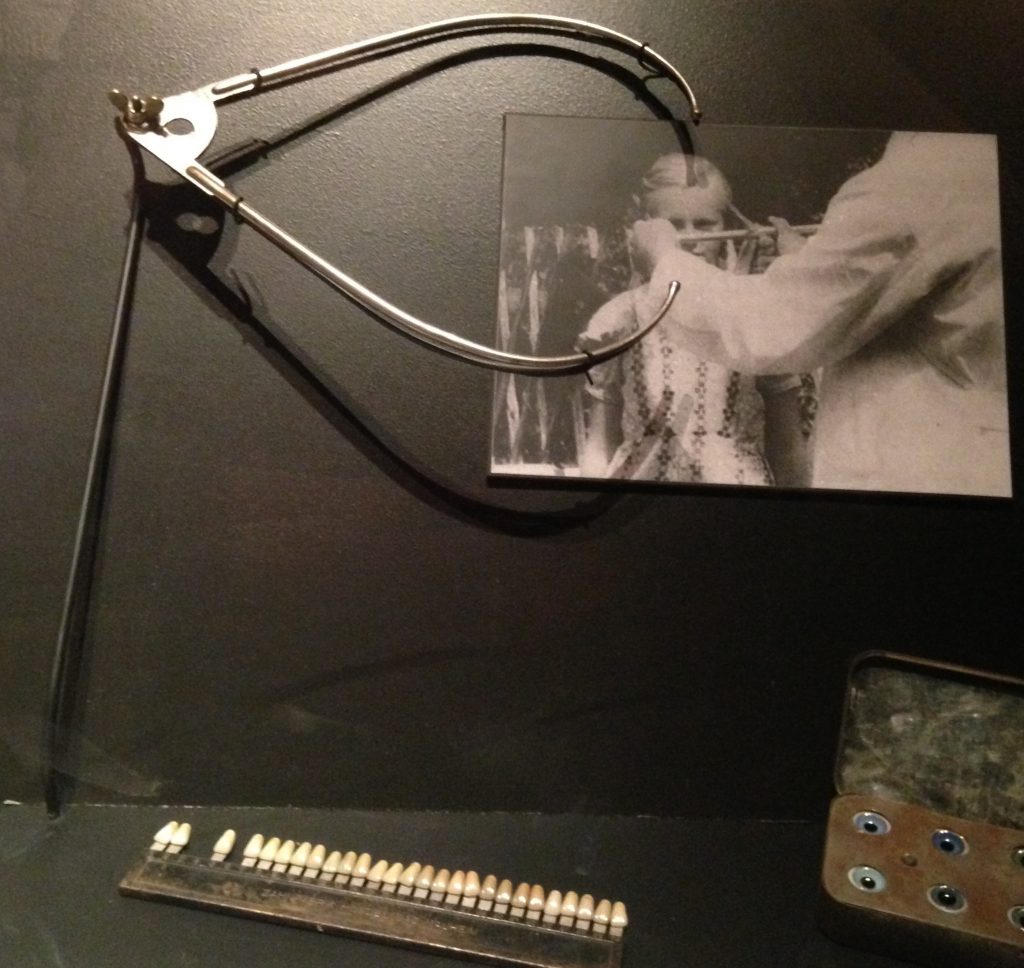
In addition to extermination, German physicians carried out inhuman experiments on prisoners. On display at the exhibit was a file which contained Dr. Josef Mengele’s “findings” as he conducted his “research”. Various tools were utilized such as calipers to measure head size, eye charts to determine vision and dental charts, all used to quantify Nazi ideology.
By the time Auschwitz was liberated by the Soviets in 1945, over 1.3 million prisoners were deported here. The Germans, realizing the end was near, forced 58,000 prisoners to evacuate Auschwitz, marching over 30 miles to the Bergen-Belsen camp. It is estimated that 1.1 million people were killed here and thousands more died as a result of the death march in 1945. When the Soviets arrived, only 7,000 prisoners remained.
The Polish Parliament mandated that Auschwitz-Birkenau to be created as a state museum in 1947. More than one million visitors come from around the world to learn about the history of Auschwitz and the Holocaust.
“Unlocking the Gates of Auschwitz 70 Years Later” celebrates the survivors of Auschwitz, details the inhumane, cruel treatment that the Germans inflicted on millions of innocent people and reminds us that we need to stand up for the freedom of all mankind.
Were you able to visit the National Underground Railroad Freedom Center for the Auschwitz exhibit or have you been to Auschwitz-Birkenau State Museum? I would be interested in hearing your thoughts if you would kindly leave a message in the comments section below. Many thanks for reading about my experience at the National Underground Freedom Center and wishing you many Happy Travels!
What to See and What to Do:
The National Underground Freedom Center
50 East Freedom Way
Cincinnati, OH 45202
Telephone: 513 333 7500
- Admission Fee: $15 for Adults, $10.50 for children ages 3 – 12, Seniors 60+ for $13 and children 3 and under is free of charge.
- Hours: Open daily from 10 AM to 5 PM from Tuesday to Saturday and from Noon to 5 PM on Sunday and Monday; Tickets sold until 4PM.
- Amenities: Historic tours, Exhibits, Geneology, Group Tours, Rental Space, African American bookstore, Gift Shop, North Star Café, Special Exhibits
- Scenic View: The view of the Ohio River and Kentucky
- Length of Visit: 4 hours
- Travel Tip: Backpacks, large bags and umbrellas are not permitted in the museum.
Where to Stay:
Millennium Hotel Cincinnati
150 W. 5th Street
Cincinnati, OH 45202
Telephone: 513 352 2100
Where to Eat:
Moerlein Lager House
115 Joe Nuxhall Way
Cincinnati, OH 45202
Telephone: 513 421 2337
I was so happy to see the Caprese Flatbread on the menu and I ordered a couple of local beers. The restaurant was busy because the Cincinnati Reds were playing and the location is close to the stadium.
During a later date, I visited with a friend where we ordered a flight of beer and the Meat and Cheese board which was served with grilled beer bread, spicy mustard, applekraut and pickles. We selected two meats (prosciutto and candied pork belly) as well as two cheeses (Red Dragon mustard Welsh cheddar, which is a favorite of mine and the Cabot Hot Habanero Cheddar). Exceptional! Additional meat and cheese samples are available for $4 each.
What to Eat:
- Skyline Chili: My go-to meal at Skyline is the 4-way chili with onion served with oyster crackers and hot sauce. I always pick up two York peppermint patties after cashing out. Cincinnati chili is a beef based sauce served over spaghetti noodles and cheese. Additional toppings include onions and beans.
- LaRosa’s Pizza: A local chain pizzeria, this Sicilian style pie is made with a sweet crust and sauce. My favorite menu item is the Caprese pesto Flatbread Pizza.
- Graeter’s Ice Cream: It’s the French Pot process that makes Graeter’s Ice Cream so decadent and rich. Towards the end of the process, they pour chocolate into the mix creating large chunks of yummy goodness.
- Montgomery Inn BBQ: Visiting the original Montgomery Inn BBQ at the boathouse is a culinary and scenic experience. Their ribs are served with a sweet and tangy sauce that has since made them the “Ribs King” and a favorite among locals. Load up on their amazing BBQ flavored Saratoga chips,
- Glier’s Goetta: While it looks like a slab of corn beef hash, this breakfast staple is made of sausage and oats, cooked until crispy. Most breakfast restaurants carry it as a side, especially the local cafes and diners.
- BonBonerie: One of the most decadent pastry shops in Cincinnati, their rich confections are absolutely amazing.
Where to Drink:
Moerlein Lager House
115 Joe Nuxhall Way
Cincinnati, OH 45202
Telephone: 513 421 2337
Books to Read:
- Eligible: A Modern Retelling of Pride & Prejudice, by Curtis Sittenfeld
- Running, by J.T. Cooper
- Dead Witch Walking, by Kim Harrison
- Beloved, by Toni Morrison
- Double Dutch, by Sharon M. Draper
- Romiette and Julio, by Sharon M. Draper
Photo Guide for Cincinnati (as provided by Chris Thompson on FourSquare):
- The John A Roebling Suspension Bridge
- Pick a spot near the Covington pier and shoot north toward the Cincinnati skyline. Shoot at sunset and underexpose by a few stops to get the lights just right.
- The new lights on the bridge create excellent stars when you photograph them using a narrow aperture (~f/16 and above) on your camera. That means you’ll need a longer exposure (and thus a tripod).
- General James Taylor Park
- Shoot from the top of the flag pole mound to get more building reflections in your shot. Shoot at sunset or sunrise for great lighting.
- Cincinnati Museum Center at Union Terminal
- Arrive first thing in the morning when the sun is coming up
- The Fountain at Fountain Square
- For great photos of the fountain: set your camera on a tripod and use a long exposure (2-5 seconds) to capture the running water. Get Carew or the colored lights above Rock Bottom in the background.
- Fountain Square (look for reflections in puddles)
- Celestial Restaurant in Mount Adams – The restaurant is now closed, but you may still be able to use the parking lot.
- Carew Tower Observation Deck
- Provides some neat photos of the highways snaking around the city. Set your camera on a tripod and use a long exposure to get moving car trails. It’s only open at sunset a few days each year.
- Engine Company 46, 2733 Erie Avenue (at Michigan), Cincinnati
- One of the most beautiful historic firehouses in all of Cincinnati. The firefighters here are used to having their photo taken while they work. Ask nicely and you can get some cool shots.
- Cincinnati Observatory Center
- Krohn Conservatory
- Great American Ball Park
- Shoot the front of the stadium around sunset to get a nice color blue in the sky. Get one of the player statues in your shot for extra effect.
- Devou Park
- The overlook next to the Drees pavilion affords a great view of the Cincinnati skyline. Shoot at sunrise or sunset for the best lighting. Underexpose slightly to get the city lights just right.
- Newport Central Catholic for fireworks
- Shoot the Riverfest fireworks from this location. Bring a long lens and a tripod. You’ll want a long-ish exposure (5-10 seconds) to capture the bursts, but make sure the skyline isn’t overexposed.
- Riverfront Park
- The colorful fountains make a great subject, but you need to use a relatively fast shutter speed (>1/20 or so) to catch the lights before they change color, leaving your pic with plain white lights.
- American Sign Museum
- Be sure to bring a tripod to capture all the signs. Manual white balance is the way to go, because there are so many crazy colors of lights that your camera won’t know how to react.
Disclosure: Please refer to our blog disclaimer tab for more information.